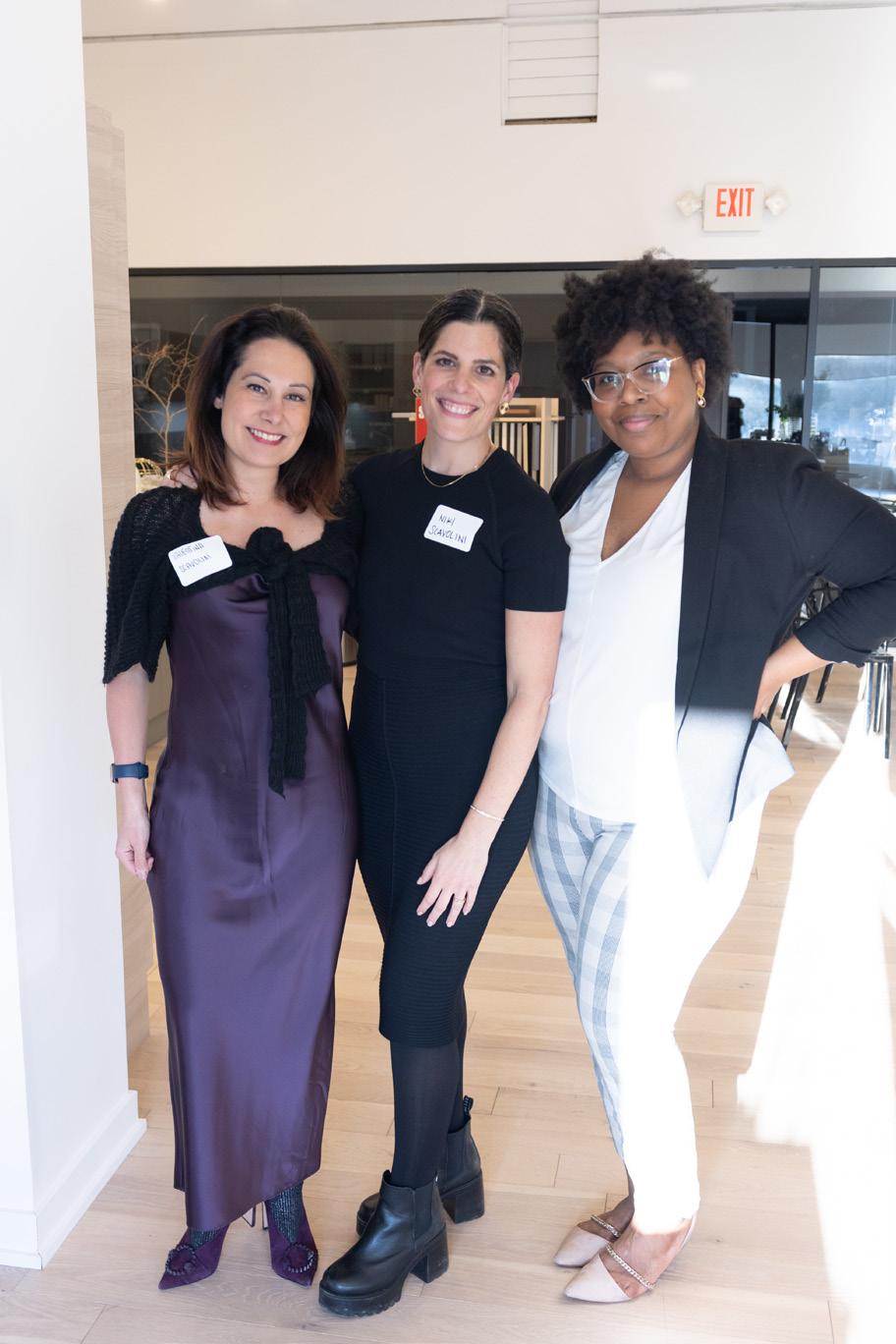






























1. An Architect can help you create and focus your dream house into a built reality.
Architects see the big picture. A skilled architect can help you develop and integrate your list of requirements with the other complex factors to create a unique home just for you by prioritizing your needs.
2.
Architects are educated, trained, and tested in a large range of areas, including aesthetic design, ergonomics, sociology, ecology, law, building codes, construction materials and technology. This breadth of knowledge allows foresight when evaluating competing requirements and restrictions.
Architects are trained to make buildings both functional and beautiful. An architect will be able to show you alternatives that you might not have considered possible.
4.
An architect has experience effectively communicating through written word, drawing, and verbally with the key members of the project including clients, contractors, engineers, and authorities in the manner best suited to the situation.
5.
Most architects consider architecture a passion more than a vocation. They draw on past experience. They are an integral part of the design/construction community with contacts in all the fields.
6.
Architects can bring pictorial suggestions to the table and assist in decisions for space planning, materials, and finishes transforming your abstract ideas into a form you can visualize.
7.
A well-conceived, designed, and coordinated project is more economical. Changes made on paper in the design phase are much less expensive than those made during construction.
8.
Great design sells from consumer products to cities. A well designed home has a higher resale value.
9.
Skilled architects work with the environment to create spaces that are sustainable and comply with ever demanding energy performance requirements.
10.
An architect will be able to assist with every aspect of a project from choosing a site, city permitting, design review board submittals to construction administration. Whether you choose to start a project from the ground up or remodel an existing space, an architect will be able to help the project run smoothly during each stage avoiding disruptive surprises.
















Welcome to Michigan Residential Architects (MIRA). The aim of this publication is to connect Michigan Residential Architects and Industry Partners in the Design and Construction industry with the general public and raise awareness of the importance of architecture and design in everyday life.

MIRA is a ground breaking community of design professionals. Our purpose is to support and inspire quality design work with the most influential and talented professionals and Industry Partners in our state.
Sixteen (16) leading residential architectural firms in Michigan came together to form Michigan Residential Architects in the Fall of 2019 to foster relationships within the Design Community and promote exceptional work in the residential real estate market. The founding members invited valued colleagues in the Design and Construction Industry to join and network with the MIRA architects. These Industry Partners include respected landscape architects, interior designers, luxury home builders, real estate professionals, artisan craftsmen, flooring professionals, construction material suppliers and construction trades such as cabinetmakers, window and door manufacturers and audio visual specialists.
The featured architectural firms have spent years honing their craft and have created award winning and sustainable projects. Their commitment to their clients, sites and budgetary constraints
have resulted in harmonious dwellings dotting every region of the state and across the nation.
Architects are socially responsible and environmentally conscious. Great architecture speaks volumes and we are proud to feature the state’s finest residential firms presenting and talking about their projects in their own words.
We have partnered with quality Industry Partners who support the architects by taking out full page ads. Without our Industry Partners’ sponsorship, this publication and the further promotion of our profession to the general public would not be possible.
This high quality print magazine is sent to the top evaluated homes across the state of Michigan and in the Metropolitan Chicago area on a bi-annual basis: on or around May 31st and November 30th
A digital version of each MIRA publication is also available online.
MIRA is also a Networking Group bringing together our Industry Partners every quarter to discuss issues concerning the design and construction industry. We have upcoming events scheduled in different parts of the state from Birmingham and Troy to Grand Rapids and Traverse City. Check out the event photos on pages 132-137
The MIRA network is dedicated to promoting collaboration among those who share in the passion of designing and creating an inspiring, well-crafted home.










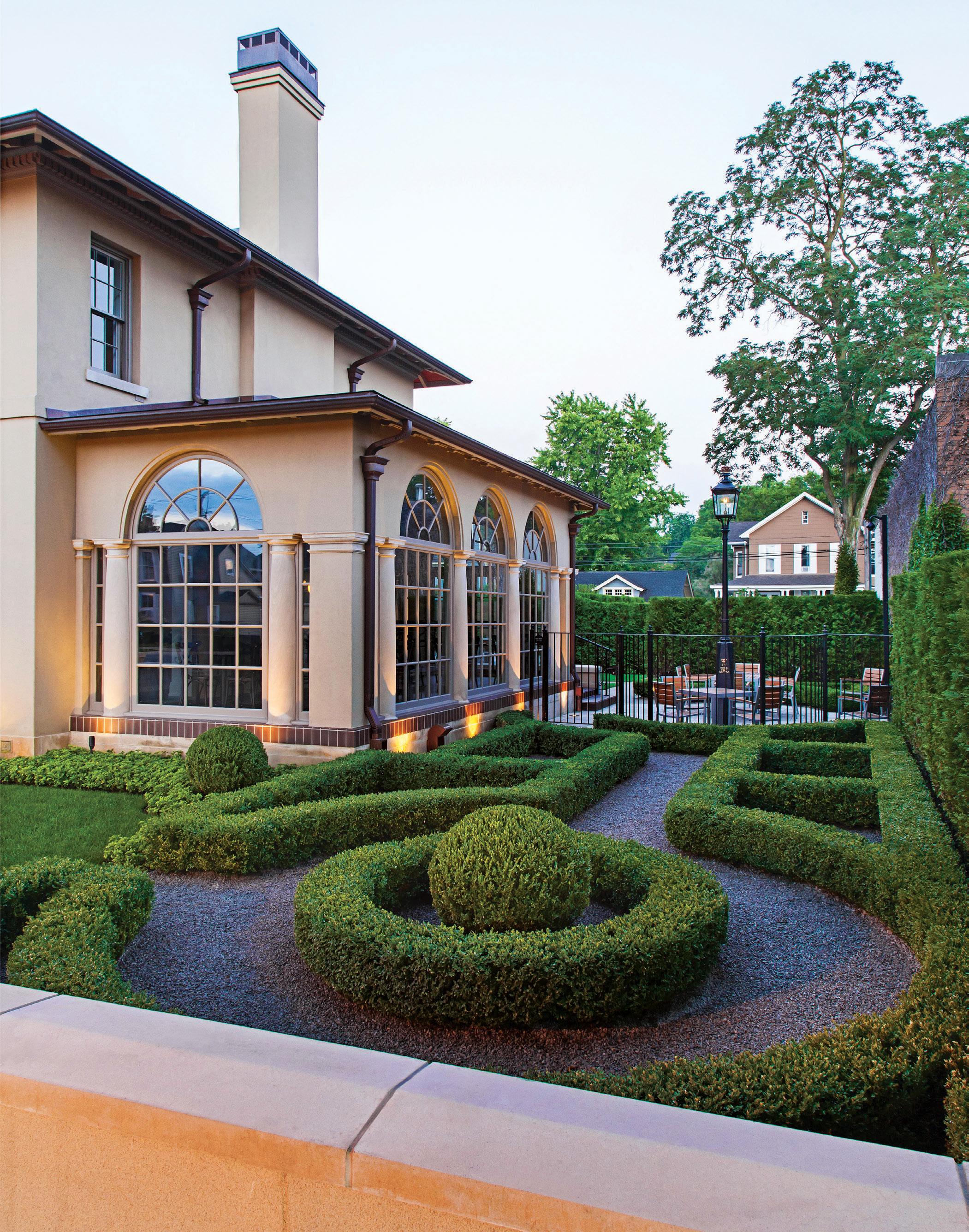



 John Allegretti FAIA, LEED-AP
John Allegretti FAIA, LEED-AP
Allegretti Architects is an architectural and planning firm founded on the principles of service, sustainability and excellence, love of the natural environment and people shepherd our firm. We see our mission as architects and planners as a social responsibility and strive to bring best environmental practices and client responsive solutions into harmony in each project. A passion for quality driven decisions are reflected in our architectural solutions. For over 30 years, John Allegretti has been principal architect for over five-hundred projects across the United States and Internationally. Our practice promotes professional excellence of affordable and sustainable residential designs. John's designs are regularly published and distributed world-wide by the home publications industry.
500 Main Street St. Joseph, MI 49085 www.allegrettiarchitects.com 269.983.1100
In April of 2019, I met a transnational couple with homes on two continents and two children who wanted a home that would be a permanent living space to call “home”. While looking for existing homes they found one that I had designed in 2005, which they liked. We discussed their program. After learning more about their needs it became clear that the home, they were looking at, would be much too large for them. I suggested that they might want to consider designing a new home on a lot. It is now the fall of 2021 and the home is just being completed. The long design and construction schedule has been the result of the owner being confined in China for a year because of the pandemic and visa restrictions and the relocation of the contractor after the first year to Idaho. Our firm seemed to be the only constant in this construction equation. We coordinated with the owner, the contractor and all of the sub-contractors by email for over a year. The site also offered challenges in that the buildable area was restricted by the front and side yard setbacks and the critical dune Michigan EGLE requirements that disallow construction on slopes greater than thirty-three percent. In order to overcome the absence of both the owner and contractor we have had to dedicate much of our practice to coordinating design as well as the day-to-day imple mentation of much of the construction. Initially our challenges were confined to developing a 2,200 square foot home on a 20,145 sq.ft. lot that had a buildable contig uous area of 6.4% or 1,289.28 square feet. Our solution was to incorporate the lower level as a basement and the upper two levels as living area. We were able to tuck a virtual golf range in the below grade lower level, as well as an entry, stair, two-car garage, and a mechanical room. The landscaping is underway including a screen wall entry walk and other site work to be completed this fall.










The owner’s idea of “home” is minimalist and energy conscious. Their new 2,200 square foot retirement home located on a northern Indiana dune overlooking Lake Michigan is just that.

A central wheel-house kitchen was incorporated into the design to separate the 16 foot high rounded ceilings in the living/dining wing on one side of the kitchen from the bedrooms, laundry, mud room, and garage of the other backstage wing. The entry hall next to the kitchen serves as a transition line between the private and semi-public areas.
Energy conservative sustainable green technologies were integrated into the home including radiant floor heat, high R value soy bean based spray on insulation, 100% recycled glass tile, rigid roof insulation, super insulated foundation walls and slab floor, interior inert non-toxic milk paint, as well as a high efficiency furnace and fireplace. The exterior walls were articulated according to interior function with terra-cotta red roman brick and colored mortar to match. The backstage wing and entry walls are yellow/buff cement stucco with anodized aluminum channels. A “turf-paved” grass driveway was also incorporated into the design.
Connect to this project on Houzz: http://www.houzz.com/projects/273673/ long-beach-residence
Connect to this project on our website: http://allegrettiarchitects.com/projects/ 2-long-beach-modern-residence



The sense of a Swiss Family Robinson nature setting shaped the small footprint three level approach with a two story attached screen porch restled amongst the trees. A park and walk site with a 24’x32’ main building and an attached 12’ x 20’ two level screen porch that sits tucked in a valley up the side of a hill, and angled to the side for views and ventilation establishes the home amongst the forest of beach, oak, and maple trees.
Seasonal views of Lake Michigan to the west are enhanced by the ascending high dune to the east. Passive winter sun will filter through the forest’s bare branches, minimizing the warming needs for the home, and the rich canopy will shade the home the harsh summer light.




Sometimes, I step back and remember, not everyone knows an architect. Most don't understand what the professional title fully implies. However, I’m pretty sure, in general, people think architects are smart and cool. I do. Apparently, so does my wife!
But I’m not interested in individual architects. I am interested in their collective impact on individual communities and the world. Building is very powerful, for good or for bad. But architecture—in my mind—is typically good. However, there are too many bad buildings. How can you tell? The outside kills the street and the inside disrespects its occupants. The space within and in-between is oppressive and dull. The exterior imposes itself on the landscape, ignores environmental responsibility and, well, just takes up space. At best, a bad building is benign, nondescript and forgettable. At worst, a bad building can inflict damage; physical and intellectual damage. Let me be clear, most buildings are not examples of architecture. There are few structures qualified to be called architecture and the ratio gets more and more unbalanced with each passing year. The bad has consistently outweighed the good and this isn’t a new trend. Despite this history of architecture being outpaced by bad buildings, the influence of great architecture is undeniable. There are moments when we know our life has been enriched by the experience of a great building. It is not uncommon to feel an emotional response to a historic cathedral, a thoughtfully designed home or a new public art museum. Most cities will showcase their most admired cultural buildings regardless of an architectural era. Frank Lloyd Wright said,“The mother art is architecture. Without an architecture of our own we have no soul of our own civilization.”
My favorite definition of architecture was made by the great 20th Century architect Louis Kahn, “Buildings shelter mankind. Architecture shelters the spirit of mankind.”
I still believe most architects aspire to achieve architecture. At least they start out that way.
A typical architect’s story begins before high school which, by definition, makes it a “calling” more than a profession. For me, I was six years old when I decided my life’s direction. Make it to college and we endure a five to six year education, broad ranging as it is exhausting. Additionally, each state requires those holding an architectural degree to apprentice in an actual practice for a predetermined number of years, usually two to three. Following internship, we take the state registration exams, equivalent to the bar exam for lawyers. Some years, only 1/3 of the students will pass the test. The test is grueling.
A passing grade allows the once young aspirant to finally call themselves an architect. Their average age is 32.
The educational gauntlet requires endurance, conviction, and commitment. Those who become architects do so because they are in love. They are inspired to make a better world. We remain forever youthful because each new day is an exercise in the complexity of engineering coupled with the self-fulfillment of creativity. Problem solving is our job. Most of the time—not all the time—but most of the time, solving those problems is a wonderful good time. I enjoy telling students I have not worked since I graduated from college.
That said, the commitment to genuinely honor a lifetime of passion requires the highest level of perseverance. Another esteemed architect, Glenn Murcutt, warns young architects “you want to end your practice the same way you started it,” referring to initial high ethical standards and the relentless quest for design excellence.

2 2
In my opinion, the manifestation of an architect’s measure can be discerned more obviously in residential design than in commercial/industrial design. The house is an architect’s playground and
Those who become architects do so because they are in love. They are inspired to make a better world.
The house is an architect’s playground and design lab. Expertise is honed, theories articulated and the consequences of one’s imposed design decisions are quickly felt.
design lab. Expertise is honed, theories articulated and the consequences of one’s imposed design decisions are quickly felt. Our clients’ limited budgets—they are ALWAYS limited—have to be taken seriously. It is this monetary respect and the highest of self-imposed standards which motivates us to pursue the most elusive and therefore, most valuable of all design skills… restraint. I have spent forty five years learning restraint. What to leave; what to leave out; when to insist; when to let go. These lessons are the result of longevity, experience and maturity.
You may find this surprising but I think being an old architect is a lot more fun than being a new architect. The accumulation of experience can, in itself, create opportunities to practice beyond one’s local community. Of course, any opportunity close to home allows the reexamination of familiar criteria and new interpretation. Home is the ultimate comfort zone, sufficient to inspire but also reason enough to leave.
It's not easy. One only has to understand the climactic differences between, say, Arizona and Michigan. The range of knowledge necessary to excel in different climate zones is hard earned and requires patience. Factoring in local history, culture, density, demographics, ethnicity and topography further complicates the challenge of designing in a wide variety of environments. But these factors are essential to make elevated design decisions. Each community, each client, each site deserves a specific architectural response. Those responses are as varied as the weather. We should expect architects to invent an architecture appropriate for each situation, relying on an integrity of materials, structure and an inherent sensitivity to nature.
Bad buildings often lead to intellectual and emotional silence. In contrast, architecture encourages discussion, imagination and wonder. Meeting the commonplace requirements is not enough. Architects do more. Design matters and desire is essential for a building team to be clearly aligned and soar beyond convention.
I have heard many people, including friends, express a desire to have a home representative of their values and individualism. They are often quite passionate and have incredible ideas for bringing their vision to life. However, they assume they can't afford it. I will ask, what is the basis of this assumption? Frequently, the answer is an impression only rich people hire architects. Certainly, wealthy home buyers have the resources to hire us. However, many, if not most, will bypass a good architect and, taking the advice of a realtor, go directly to a builder… not unlike lower-income buyers. The results: an assemblage of mediocrity and conformity distinguished only by scale.
Sound harsh? It is. I would like to believe it is not my nature to be negative especially when I’m writing about my favorite subject. But, do I have your attention? The longer I practice, and the more I teach, I realize good architects are a building project’s best investment. Why use an architect? Would you enjoy an inspired environment that changes with earth's orbit? In addition, houses are expensive. Considering the number of dollars, could your personal investment benefit from having an experienced advocate? Would you like to have an ally, committed to more than simple profit, independent of all the other required entities standing to profit?
More than once, I have informed potential home buyers their most appropriate design (some say style) has not yet been built. It is the family’s originality of lifestyle combined with budget, and their site’s determinants of solar orientation, views, access, privacy, topography and size that creates the architectural idea. Could your home investment be based on a clear IDEA larger than you? What are your priorities?
Architects are a community asset. We are in a unique position to influence public policy, shape history and promote health, safety, and magic. We want to make a better world through architecture.
That makes us pretty cool.
kevin@azdarch.com

248.540.6009 www.azdarch.com
AZD Associates-Architects is a full-service architecture and design firm based out of Bloomfield Hills, Michigan with an extensive portfolio of projects across the country, including Canada and the Caribbean. AZD stands at the forefront of architectural design. Striving for excellence, AZD has received over 120 design awards including the “governors award” for design excellence and have had their projects showcased in various national media outlets, including HGTV, Better Homes and Gardens, MTV and Architectural Digest. For nearly 30 years, AZD Associates-Architects has utilized innovative thinking and a passion for design to forge a company that has nationwide recognition for design excellence.

Established in 1990 by Kevin Akey and Frank Zychowski, with no detail too small, AZD has produced both commercial and residential properties. Kevin heads up the residential department and Frank oversees the commercial side of the company. Together they shared a vision of creating a company that took architecture and design to the next level. Experience, creativity, and passion have separated AZD apart from other design firms.
6905 telegraph rd, suite 230 bloomfield hills, mi 48301 1121 nw 51st ct, ft lauderdale, fl 33309
Kevin Akey

































921 W. Eleventh Street Suite 2W Traverse City, MI 49684 www.sbourgeois.com sarah@sbourgeois.com 231.947.2700
Sarah Bourgeois AIA loves to work with people and has mastered the art of listening to her clients. “It’s our duty as architects to listen and create spaces that make sense based on our clients program, in other words: design is a process that organizes the convergence of a lot of moving parts such as site and client’s vision.” Her office, Sarah Bourgeois Architects, is a full-service architectural design firm that provides a full range of architectural and planning services focusing on custom residential, remodeling and small commercial projects. Her work is found in and around Leelanau County, Traverse City, Charlevoix and the Detroit area. Sarah Bourgeois Architects has participated in the design and construction of a wide variety of building projects and her firm brings the skills needed to coordinate design documents and input from both owner and consultant along with (of course) a terrific personal design sense. Past experience includes all aspects of project development: schematic design, site layout, design development, construction documents, job coordination and job site supervision.






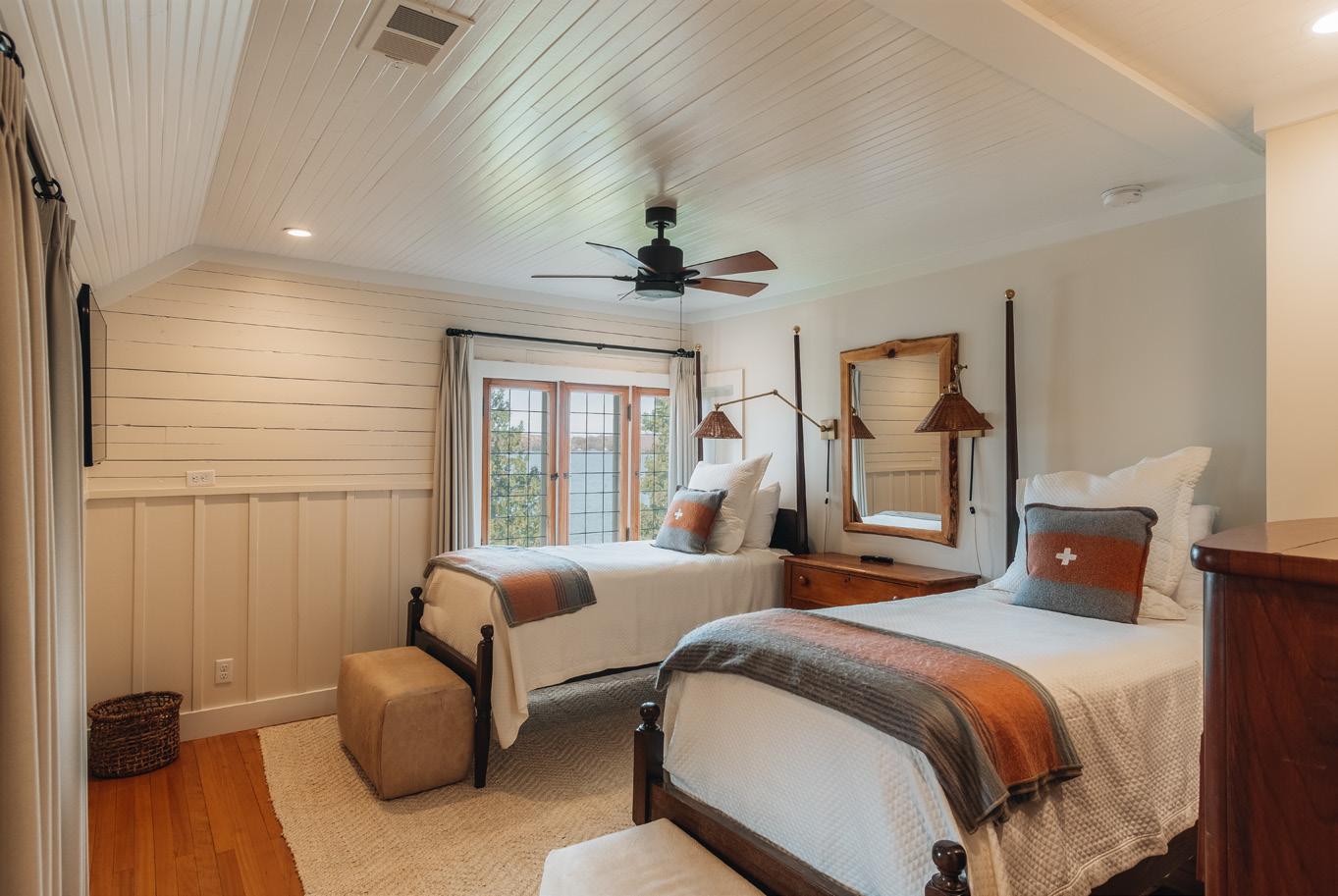




Originally designed by DesRosiers Architects in 1982, this home recently returned to the firm’s drafting boards and underwent a significant renovation enhancing the aesthetic, technology and livability for the 21st century. Nestled on the shores of Shinanguag Lake, the modern design retained its original lines, which served as the perfect canvas to add living space and innovative features including a home theater, a negative-edge pool, and a pivoting entry door. Founded by third-generation architect, Lou DesRosiers, DesRosiers Architects has been creating and recreating homes for over 50 years.









 Goodrich, Michigan
Goodrich, Michigan



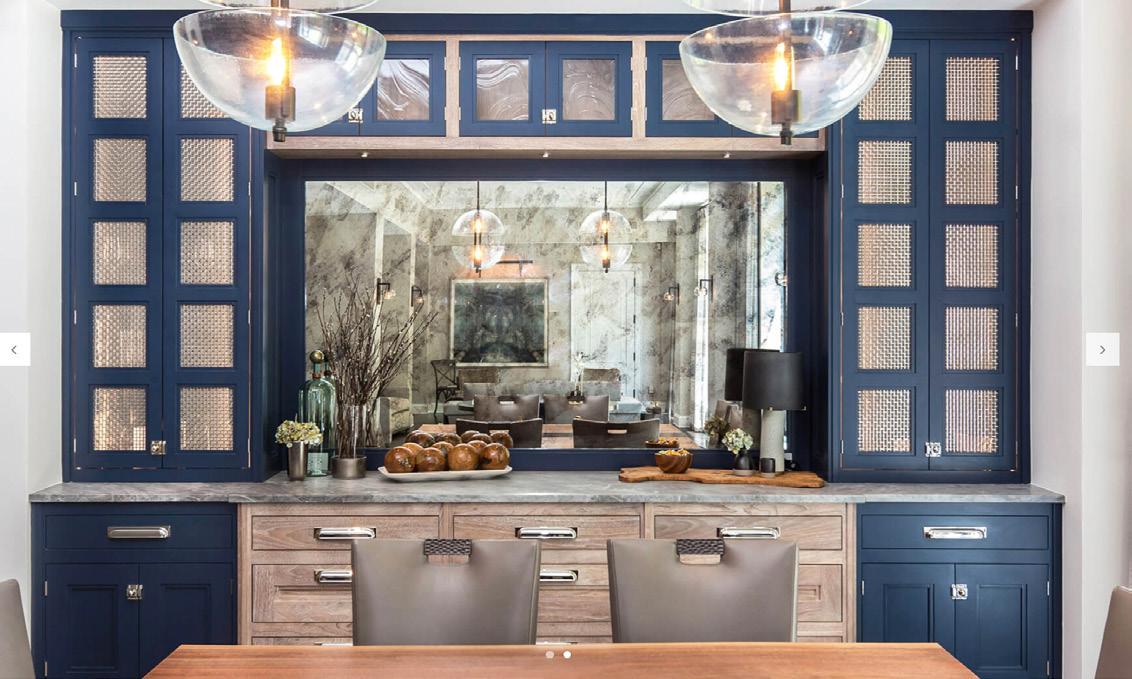


Mark Johnson and Associates was founded in 1997 in southeast Michigan by principal Mark Johnson. MJA offers a multi-disciplined team of professionals who work collaboratively, matching expertise to client/project needs. Architecture, Interior Architecture, and Furnishings are available as individual or turn-key services.
Considered one of the most thoughtful talents working in Michigan, Mark Johnson believes that residential architecture and design must serve the client’s individual needs and function as beautifully as it looks. For a project to be successful, his focus is not only on the importance of getting the architecture right, but that good decoration is of equal importance, and should always be a portrait of the person who lives there. The composed placement of a window and the position of a favorite reading chair facing a remarkable site vista are of equal importance to create that perfect integration of function and personal style.
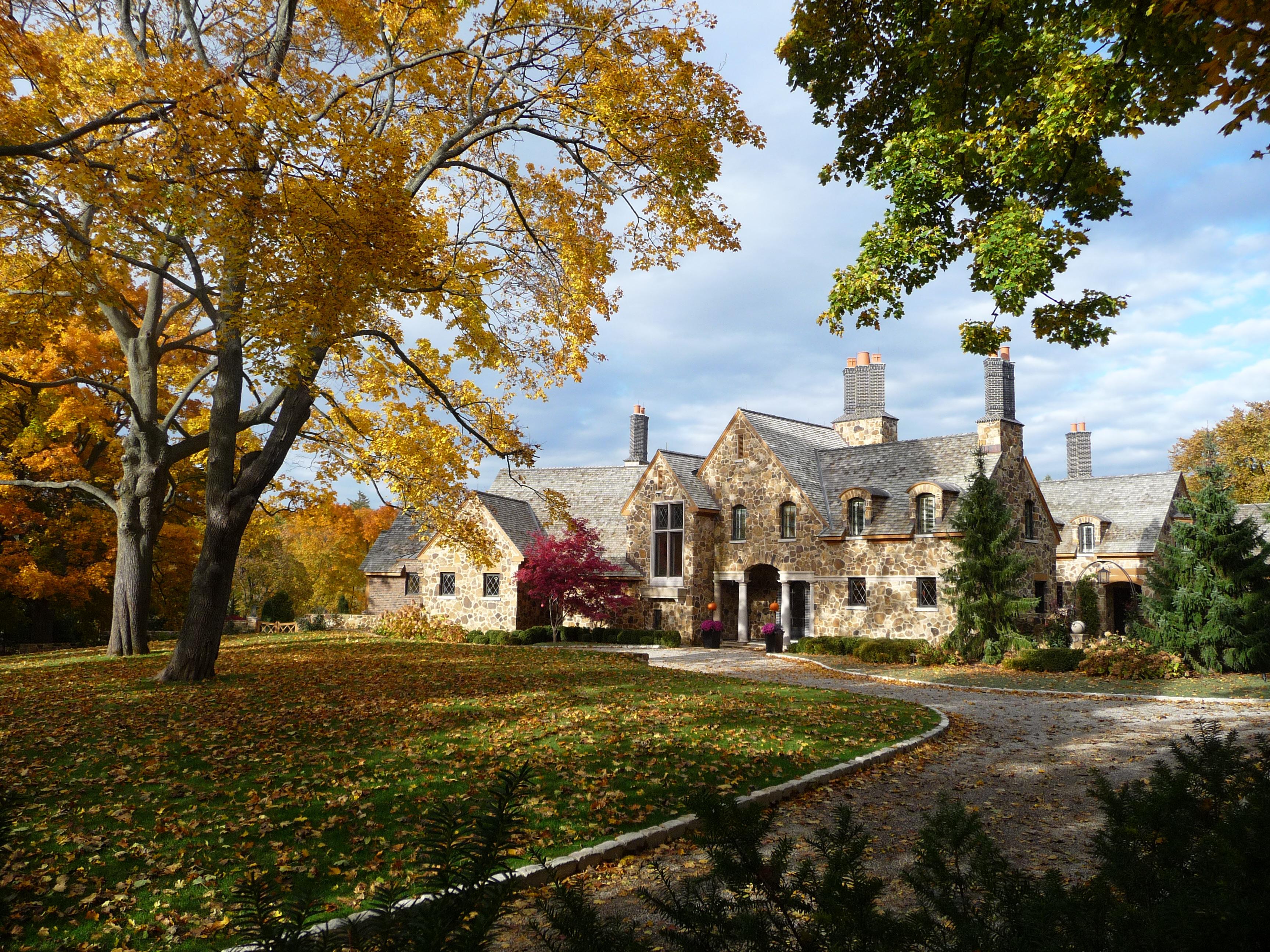
MJA specializes in residential design in no particular style. Design focus is to bring to modernism a touch of warmth and personality, and to traditionalism young energy and a touch of the exotic. Details, both bold and subtle, are layered to allows the character of a home to reveal itself over time. Great homes improve with use and age and develop thru memories and permanence into inheritable heirlooms.
Residential Architecture & Interior Design 7310 Kingswood Drive, Bloomfield Hills, Michigan 48301 Phone: 248-543-5411 Fax 248-543-5118 www.mjaarchitects.com
 Principal, Mark Johnson
Principal, Mark Johnson
“Design… is not the Pinterest or Instagram moment, it is about the level beneath the first impression, like a book or poem that one reads over and over again that gets better with each reading.”
Tom Kundig, architect
 Mark Johnson and Associates
Mark Johnson and Associates

“The best rooms have something to say about the people who live in them”
- David Hicks
Whether you’re remodeling your entire kitchen or looking to add a single upgrade, select products that reflect your personal sense of style. Consid er these four trends to personal ize your next kitchen upgrade.
High-tech culinary coaching: The use of smartphones and other mobile technology allows for quick access to information. And now you can easily customize your cooking experi ence with helpful information offered by smart appliances. Some of today’s most high-tech wall ovens include a gourmet guide within the oven itself that directs meal prepara tion for more than 50 food options, including desired doneness and the type of pan to use.
piece of jewelry completes the look of an outfit. Think of layer ing light in the kitchen with task lighting under the cabinet, recessed lighting above a new range and pendants above the island or breakfast bar.
Perfect finishes: Give your kitch en a richer, more interesting feel by mixing materials to create a space that is uniquely yours. Pair faucets and fixtures in matte black or dark finishes with delicate jewelry accents in lighting. Pick a dominant metal and then contrast it. If most items in the kitchen are finished in chrome, add a brass light fixture.
also reduces the need to open and close the main refrigerator multiple times.
• Warming drawers provide a great way to keep prepared food hot and fresh. They also work well to warm dinnerware, cups and even towels.
• Built-in coffee systems provide barista-style coffee and free up counter space. Most models also provide instant hot water for teas, soups and other hot dishes.
Color in unexpected places: Many homeowners keep their kitchen looking fresh and vibrant by adding a pop of color to an accent wall or by selecting colorfully coordinat ed cookware and small appli ances. Building on this trend, a pop of color in a non-tradition al space such as the exterior door of a range or in a sink basin is a fun and unexpected design detail.
Illuminated spaces: Lighting adds a beautiful finishing touch to a room, much like a special
Once the right personal touch es are selected, consider all the ways you can enhance your kitchen with these functional additions.
• Proper ventilation is key when selecting a new range or cook top. There are numerous range hood styles available to com plement a ventilation system’s functionality.
• Undercounter refrigeration is popular with parents, as it’s an energy efficient way to store items such as juice boxes, finger foods and kids’ snacks in one easy-to-access area. It
• Induction cooking relies on magnetic technology to heat the cookware and uses far less electricity than standard cook tops and ranges. The heating response isn't just fast – it's instant! You can boil a pot of water in three minutes. And because induction cooking only heats the pot and the area directly under it, the surrounding area is safe to the touch even when in use.
Many homeowners keep their kitchen looking fresh and vibrant by adding a pop of color to an accent wall

2076 M-119
Petoskey, MI 49770 elaine@ekarchitect.com www.ekarchitect.com 231.439.0472
Building a dream is so much more than four walls and a roof. It’s where you and your children and grandchildren will find comfort and share life; it’s where your business will make a name for itself serving clients. It’s where life happens, every day!
Elaine Keiser Architect’s one-of-a-kind designs span all architectural references, from a sprawling Craftsman estate, a quaint Victorian, a long-coveted log cabin built off the beaten path, or a Contemporary two-story that’s picture-perfect for a growing family. With over twenty years of experience, Elaine designs custom homes that integrate into the landscape and showcase the natural features. Each design is tailored to the specific needs of the client. Elaine reviews the intimate details of how a family lives, plays, works, and entertains before starting to design their home. When completed and built, the home works much like the family does, with convenient routine, thoughtful care to daily activities and beauty that is revealed through the most simple, yet meaningful details.
Elaine Keiser brings excellence in all phases of design, from conception to completion, while making the process fun and enjoyable. Building the home of your dreams has never been easier.


Are you ready to get started on your dream? We’re ready, too!



















Lucid Architecture is a West Michigan based architecture practice focused on creating engaging and meaningful homes for discerning clients across the country.




Our projects are inspired by a passion for modern design coupled with a deep understanding of site, context, craft, and detail. We create unique modern homes of all scales and sizes for equally unique clients. The homes we design are modern, purposeful, and user-driven. They welcome gatherings, encourage family, and enhance everyday life. In short, these homes become the backgrounds for your most unforgettable moments and experiences. It’s where the best things in life happen.
We’ve honed our award-winning design process while working with dozens of clients on projects located both near and far. Building a new home is something that most people only do once or twice in a lifetime. There are many unknowns, questions, and gray areas. Our top priority is guiding our clients through the design, decision making, and building process, while making it not only a positive, but exciting experience.
Eric De Witt, AIA Principal201 W Washington, Suite 250 Zeeland, MI 49464
www.lucidarc.com info@lucidarc.com 616.741.0044


 Northshore Residence - In Progress
Northshore Residence - In Progress



Infusion Kitchen & Bath Show rooms are an extension of one of the largest plumbing supply houses in the Midwest. Estab lished in 1965, Etna Supply has become a key component in meeting the needs of contrac tors, engineers, architects, plumbers and homeowners. Our Philosophy? Simple. Offer exceptional service and prod ucts with competitive pricing and on time delivery.
With thousands of products on display, come and experience a showroom like no other. Work ing kitchen faucets, shower heads and fixtures, and toilets offer a way for you to see and feel the products before purchasing them. Infusion Kitch en & Bath Showrooms offer creative solutions and luxury products for your home that can fit with every style and budget. Our six Michigan show rooms are located in Grand Rapids, Grand Ledge, Holland, Kalamazoo, Traverse City and Wixom. Our professional consul tants offer a wealth of knowl edge & experience in the decorative plumbing industry; and are here to assist you in making the right selections, the first time.
Not in Michigan? Not enough time to shop? No Problem!
Our staff is experienced in assist ing customer via phone, video conference & email. We under stand today’s busy lifestyles
leave limited time to shop for the home. We will guide you through the entire process; making sure that you have all the little parts and pieces needed to make everything work properly. Don’t know where to begin? Let us help!
Simply give us an idea of what you are looking for and we can send you multiple selections to review. Our consultants have put together many kitchens and bathrooms and can put together a customized pack age just for you.
A wealth of knowledge & experience in the decorative plumbing industry

560 Fifth Street NW, Suite 405 Grand Rapids, MI 49504 616.920.0545
MATHISON | MATHISON ARCHITECTS (MMA) is founded on the conviction that architecture, planning, and design elevate lives. We explore ways to expand the possible and discover new opportunities to improve function, comfort, and sustainability.


We are committed to rigorously planning and executing ideas that enhance the dialogue between subject and place, connecting the aspirations and optimism of people with strong, evocative architectural form.
Our process is grounded in iterative design thinking and the belief that each project draws uniqueness from its site and program. We are as focused on common-sense, practical solutions as we are on handsome detailing and the spatial interplay of light, material, and texture.
We are interested in the detail and the follow-through of each solution, believing that our clients and their projects are served best by our attentive advocacy through the entire planning, design, and implementation process.
Learn more at mathisonarchitects.com
A family envisioned a modern beach house on Lake Michigan that promoted indoor-outdoor living. While committed to a cohesive, modern aesthetic, the family was willing to prioritize view and experience. Window locations maximize the aperture to the lake and reinforce a sense of tranquility and balance. The site’s modest footprint and striking visual opportunities demanded a democratic distribution of program, placing sleeping and gathering spaces collectively westward, and circulation on the roadside. Bedrooms occupy the upstairs, allowing the primary suite a roof deck with a sweeping vista. Living space at the main level doubles in size through large sliding glass doors to a deck with direct beach access. Large overhangs and a trellis invite this extended experience in warmer months and regulate summer sun. While propping up the high-use zones, the lower level also does the work of a classic Michigan beach house, with an outdoor shower, an ample bunk room, and a changing bath.
 Builder: Denali Custom Homes
Builder: Denali Custom Homes


 LAKE MICHIGAN BEACH HOUSE
LAKE MICHIGAN BEACH HOUSE
MATHISON | MATHISON ARCHITECTS (MMA) focuses on a collaborative, concentrated approach to architecture.




We believe that the integrated vision of a project should be considered throughout the design process with all disciplines, so that at completion, no detail feels divergent from the whole. Each aspect of a space should enhance the depth of the architecture, reinforcing central themes in progressively captivating layers of design.
We emphasize functionality, spatial relationships, and precision, while being thoughtful about the impact to the environment and user. We create details that knit spaces together, that are purposeful, provocative, and express beauty in their craft.
As Architects and Designers, our goal is to help clients unlock and express a vision of their environment that aligns with their values.
Learn more at mathisonarchitects.com




Seeking a quieter lifestyle in a natural setting, the owners purchased a 2.5-acre site in a quintessential Lake Michigan dune forest, to build a warm, modern place of comfort. Our team’s primary interest was a house siting that respected cues from the landscape. An elevated bar of living space, floating in the trees, that harnessed southern light, naturally emerged as the central organizing principle.
The generous kitchen is the heart of the main level, connecting directly to every space on the floor, including the mudroom and garage. As passionate cooks who spend ample time sharing food, elevated views, access, and spacious comfort here allows for hospitality, creativity, and efficiency. The living room’s vaulted ceiling is a surprise volume, which honors of the drama of the western forest view that it frames.



“It’s so easy to integrate Western Window Systems’ large sliding glass doors into these window wall systems with thin profiles so that you get a much more uninterrupted fenestration pattern.”
- Robert Gurney, architect
















When building a custom pool, think of the project as a luxury home: Call a trained specialist.
An experienced custom pool designer/builder may complete as few as a half-dozen projects annually — preferring to deliver the finest quality pools and spas.
Similar to a home architect, a premium pool-builder will first visit the site, even if it’s still raw land or includes an existing home without a pool. The company will take soil samples, will visualize the best location for a pool, spa, other water features such as waterfalls and wiers and accompanying structures such as a cabana or casita. If the home has an existing pool, the company can determine whether it should be salvaged or a new one would better satisfy client specific needs and budget. Sometimes, rebuilding an existing pool can cost more and deliver less.
What is the scale of the yard, the house, what is the best dimensional configuration and sun siting so that the pool fits just right, and not just fits. How about decking, hardscaping, artificial lighting in and out of the pool? Remote and computer controls?
Early on in the process, gas and electrical lines need to be marked and retaining walls, planters, solar arrays, drainage, irrigation should be plotted. Placing a pool too close to irrigation can destabilize the expansive soil that characterizes most of the Valley. That can weaken the pool structure, no matter how well it’s been designed and engineered and the concrete poured and finished.
At the very least, a good pool design considers clients’ stylistic likes and dislikes, the intended use -- diving, lapping, volleyball, swim-up bar, even just for show
-- and the colors and textures of the new or existing home. Quality companies take the time to investigate how the pool is going to be used before jumping in on its design and estimating.
Further, incorporating what the architect has accomplished or is planning for a newbuild or renovation is essential. After visiting the site and the homeowners, a quality luxury pool builder will meet with him or her as soon as possible. Everyone on the design team should be as focused on achieving that the pool design fits its home context.
While the best volume pool builders build quality products, their expertise is in templating pools and designing individual pools to clients’ needs from these. Compare buying a suit off the rack to having it tailored. One might fit perfectly, if you’re built just right for that suit, but most people aren’t, just like most sites and lifestyles do not match a template. Design costs a little more, yes, but bad design can cost you the enjoyment you’re striving to achieve.
Custom pool companies design for specific needs; they are also skilled and experienced in pool design and color theory. They are not volume driven or sales driven but lifestyle driven, offering a plan with the same quality standards that a room addition requires.
When choosing a potential pool builder, one should find a company that will design a pool/spa that fits his or her life. The goal: To not just add a luxury item but intensify the overall home experience for the occupants and its guests. That means, in the same spirit as an architect and interior designer, a quality pool builder will offer insights and options to ensure a healthier living environment.





108 Center St. Suite 205 Northville, MI www.josephmoseyarchitecture.com Joseph@jma-architecture.com
248.515.4477 Elk Rapids, MI 231.498.2500
nc. we believe that all created meless and beautiful A project is all projects deserve our best ence, talent, passion and skill, and rchitecture is our obligation to creation of beauty in the built process and a partnership between the client, design team and construction team. A combined effort through which we strive to achieve a result as unique and personal as each individual client. If we achieve this, we feel we have succeeded.
We are a small boutique style firm which is one of our greatest assets. The Firm Principal is the client design and construction contact through the entire process.


Joseph Michael Mosey, Principal, learned the craft of Architecture over many years with both commercial and residential design firms. He holds current architectural licenses in four states (Michigan, Illinois, Georgia and Ohio) and a current Michigan Builder’s License. He graduated from the University of Cincinnati in 1991 with a Professional Bachelor Degree in Architecture. The University of Cincinnati College of Design, Art, Architecture, and Planning is well known for a curriculum that emphasizes creativity and design and is always ranked among the top five Architecture programs in the country. JMA employs the talents of architects, project managers and draftsman to complete the project team, each with unique skills and experience tailored to the needs of each client.


"When done beautifully, Architecture will have the same power over the mind as music or poetry or any works of Art, creating meaningful human experiences"


Good Architecture is our obligation to each and every client and if done properly to our standards will tell the story of its client, its owner, its family.







"The ultimate goal of the Architect is to create a paradise. Every house, every product of Architecture... should be a fruit of our endeavor to build an earthly paradise for people"










Doors have been an important part of any home’s interior design ever since the ancient Egyptians first imagined rooms divided by doors. That’s right, before them, no doors. And they quickly evolved their new invention into beautifully carved statements of status and style.

Maybe that’s why door pack ages are so important to new home builds or remodels. With a bit of knowledge, preparation, and a good contractor, archi tect, or designer, creating the perfect door package can be an enjoyable, satisfying process. One that would make our most discriminating Egyp tian ancestors envious.
The overall style of your home most directly suggests the type of wood for your doors, or at least narrows your best options.
Lake Retreat (Knotty Alder, White Oak, Fir, Paint Grade)? Modern (Walnut, Mahogany, Rift Sawn White Oak)? Or some thing in between? Each takes you to a different part of the wood spectrum, which is surpris ingly broad. But coming into the selection process with a clearly defined style is a good first step. Next, look to your flooring and kitchen cabinetry.

Designers and architects like to think in terms of flow. Do they see your doors as contrasting
elements that separate spaces, or should they blend (“disap pear”)?
One more important point about style; is your goal Timeless or Today? For some, a more Timeless style guards against feeling “Oh, that’s so 2022” in five years. For others, the thought of redecorating in 2027 with an updated version of Today stirs their passion. Your choice, but worth considering early in your decision process.
Okay, what’s next?
Trust your builder, architect, or your designer to recommend a good one or two. But do your homework, too. Go beyond the beautiful brochure and look at years in business, company history, and warranty. Are they innovators or stuck in the past? Is their manufacturing process toxic or eco-friendly? Call them. Heck, go visit them; custom doors, especially door packag es, are an investment. An invest ment you’ll look at and touch every day.
Creating the perfect door package can be an enjoyable, satisfying process.
Actually, a lot. Obviously, the hardware. Levers or knobs?
Electronic or traditional locks?
Type of metal?
Pocket or swinging doors?
Jamb options? Inlays? Glass panels?
And lastly, finishes.
A good custom door builder will offer unlimited finishes. And finding exactly the right finish often takes a door design from “That will work” to “Perfect”. Which, of course, is where you want to be.
We’re not suggesting you’ll want or need to make all these decisions; your designer, archi tect, or builder normally come with suggestions. But knowing there are lots of parts of an interior door package will help you in this process.
There are many door manufac turers that build quality doors.

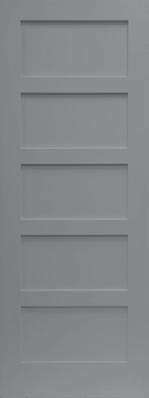











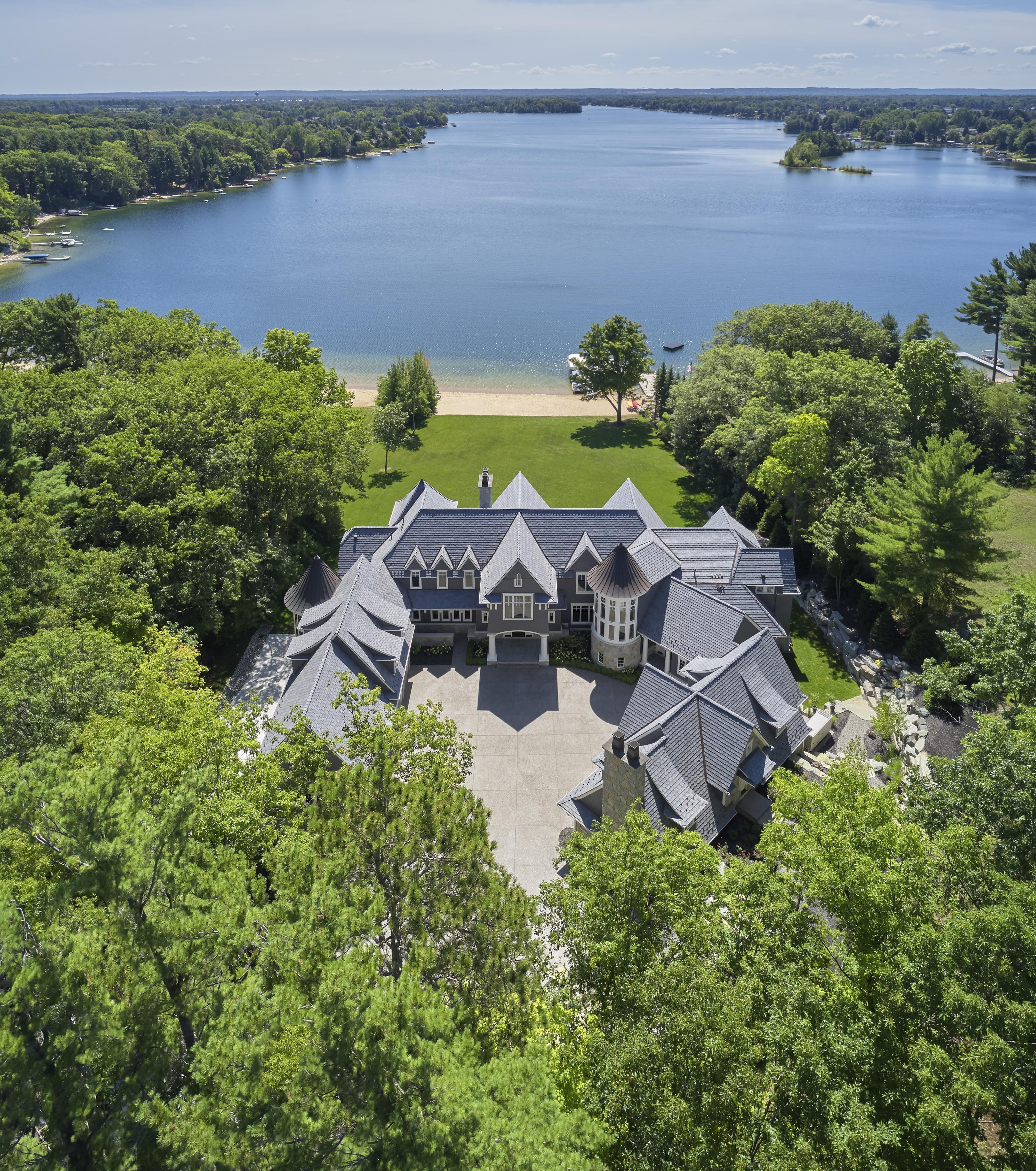
 James Haefner Photography
James Haefner Photography




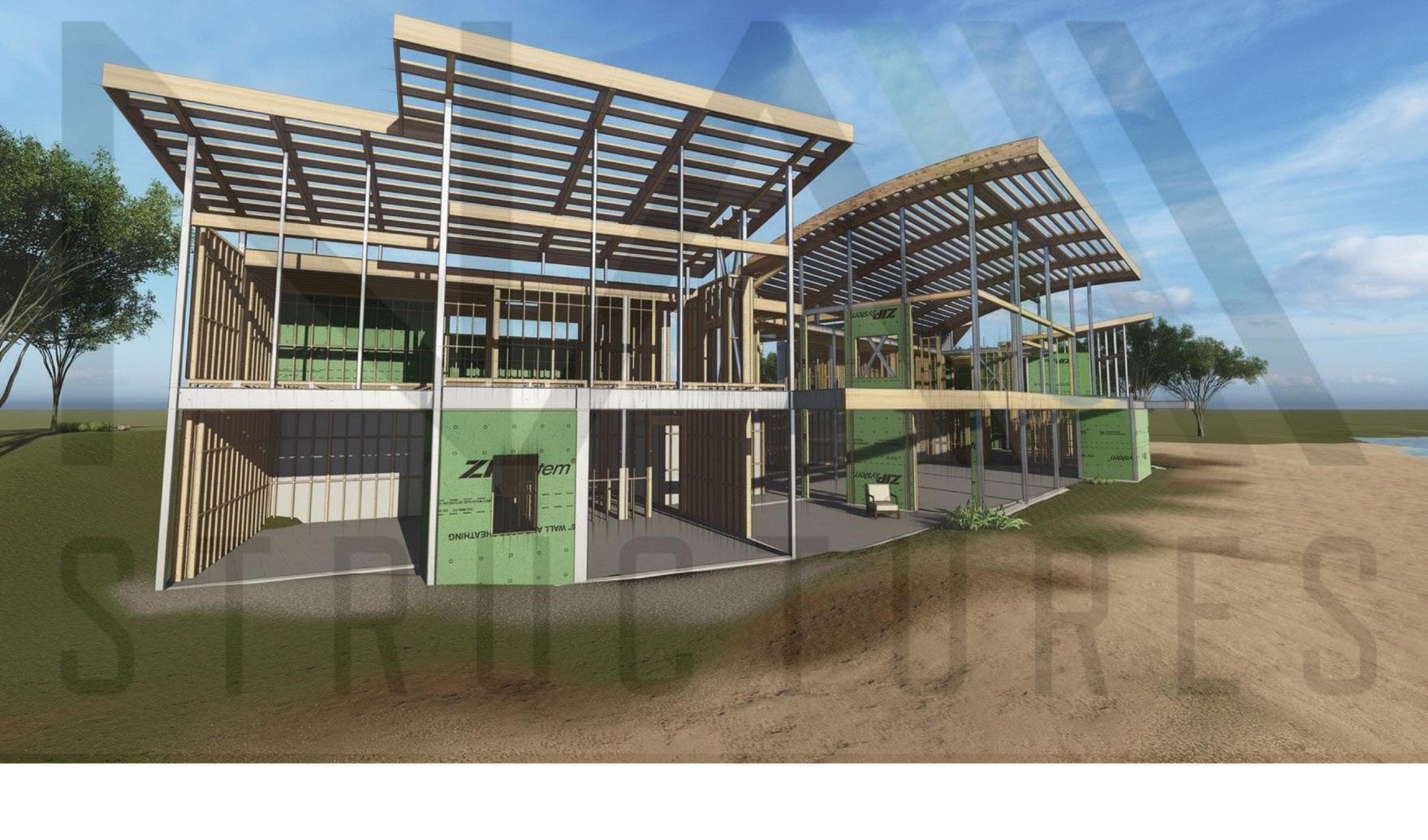



For the rst time, leading architects, master builders, and discerning clients can achieve extraordi nary, seamless results from the extensive utilization of our BIM Modeling Technology and Systems.

Our 3D modeling provides a new level of coordination, resulting in the most precise structural analysis which in turn delivers accurate assembled and fabricated components.
Our unique vertically integrated envelope o ers the builder a single source solution for the structure. For all structural steel, wood and engineered components, including walls, roof and oor systems.


430 N Old Woodward Ave Birmingham, Michigan 48009

info@SarokiArchitecture.com SarokiArchitecture.com 248.258.5707
Saroki Architecture believes that excellent architecture can be achieved at every level. From small interior details to urban spaces, the firm’s work has improved the quality of life in many communities, and that exposure has advanced the course of sustainable and durable architecture here in Michigan.
Using the best principles of urban design and sustainable architecture, Saroki Architecture has created spaces with obvious synergy and resonance. Its buildings have created places and attractions that have evolved the social, cultural, and financial well-being of many communities.



Say the words “wine cellar” to a dozen different people and they are each likely to imagine something completely different.
One person might picture a cavernous dark room sunk deep below the ground where oversized wine barrels lay in wait; someone else may envision a cabinet sized wine refrigerator located conveniently in their kitchen island; and yet another may visualize a sleek, contemporary wine cellar located right in their dining room that serves the additional purpose of being an eye-catching piece of artwork.
The great thing about wine cellars today is that they can be created to serve your exact needs, no matter how much room you have (or do not have, for that matter) to indulge your oenophile instincts.
Those who have taken up the tasty hobby of collecting wine will tell you that you must “protect your investment.” Whether you are going to seek out rare reds or stockpile cases of your favorite Yellow Tail, you’ll want to know those precious bottles will be at their peak when you decide to pop the cork. The only way to have this kind of assurance is to store your selections with the proper balance of temperature and humidity; fail to do this and your corks could crack or rot, resulting in a tainted bouquet.
The wine cellar has become a must-have amenity for new high end homes, much like the home theater and the gym, and some people also convert existing unused spaces in their homes into wine cellars. Not even the shaky economy and the uncertainty of the housing market have kept home owners from building wine cellars. In fact, the addition of a wine cellar to a home adds value
and has become a selling feature for new and existing homes.
Architects, home builders, and interior designers all agree that wine cellars are extensions of the idea that the home is not only a place to live, but also a place to entertain. The aesthetically pleasing and warm ambience of a wine cellar becomes a focal point in the home, a place where people congregate and enjoy conversation.
One reason that wine cellars have become so prevalent is that, as more people drink fine wines, they are learning the value of letting some of them, particularly tannic reds, improve with age. For many people, a home wine cellar is also about protecting a valuable investment. However, you do not have to be a collector of fine wines to enjoy the benefits of a wine cellar. The casual wine enthusiast can also benefit from and take pleasure in having a wine cellar.
Storing wine properly is not just a good idea, it is a necessity. If you do not store it properly, your wine will turn to vinegar. The technical aspects of a functional wine cellar boil down to a few basics: temperature, humidity, and proper construction. The optimal temperature range for wine storage is 55-62 degrees, for both red and white wines. While served at different temperatures, red and white wines must be stored at the same temperature. Some wines are made to age and some are meant to be enjoyed right away. The right storage protects them both. A properly constructed wine cellar will keep bottles away from heat, direct sunlight, vibration and oxidation.
In addition to the technical side of storing wine, there are many aesthetic considerations you will need to ponder: What kind of racking system do you need
- Mahogany wood for a Mediterranean feel or a suspended metal system for a floating, more contemporary feel? Perhaps your home is accented with old-world elements so you may want reclaimed wine barrel racking. Have a more eclectic home? Consider a mixture of wood and metal racking for the home with a more eclectic décor. And the choice of the wine racking is just the beginning.
Would you prefer an ornate iron and glass door or a stately carved wooden one? Will it be necessary to incorporate a ladder? How about material for the counter top, walls and floor? Do you want the lighting to make a statement, or blend into the background unnoticed? Perhaps you even have some stellar cellar art that you want to integrate. The material selections to complete your cellar are endless. The list is long, but these finishing touches complete the cellar and reflect each person’s unique tastes.
Whether it is for maximum looks or maximum function, wine cellars add value to homes, provide a dwelling for one’s collection, and offer a place to gather with family and friends. Whatever the function for your wine cellar, one thing remains true; wine cellars have come into their own and are now the hottest trend in home design. Wine is hot and so are wine rooms.
For more than a century, Hope’s has handcrafted the world’s nest steel and bronze windows and doors, and we continue to re ne the art that makes them the most sought-after and longest lasting windows and doors available. Hope’s exclusive hot-rolled steel and solid bronze pro les replicate the traditional aesthetic of historic buildings while providing modern performance and ef ciency. Hope’s windows and doors are built to last a lifetime and beyond – sustaining their beauty and performance for generations. HopesWindows.com
PRODUCTS SHOWN: Jamestown175™ Series steel windows and doors
ARCHITECT: Michael Hricak Architects PHOTOGRAPHER: IMG_INK
 PRIVATE RESIDENCE
PRIVATE RESIDENCE
16 Ionia Avenue SW, Suite One Grand Rapids, Michigan 49503
rbsears@searsarchitects.com www.searsarchitects.com 616.336.8495
Sears Architects is a boutique architecture and planning firm located in Grand Rapids and Harbor Springs. Robert Sears, Principal, has a passion for working with clients to design their personal home. Our work is heavily influenced by shingle-style architecture and the East Coast vernacular as a result of time Sears spent practicing on Nantucket and in Connecticut in his career.
Sears Architects, launched in 1995, provides a suite of design and planning services to clients throughout the design process. The firm works with private individuals, developers, and historic residential associations throughout the Midwest, and as far as Seattle, New Jersey, and Florida.

New construction homes and cottages, historical renovations, neighborhood design and neighborhood planning are highlighted in our online portfolio at SearsArchitects.com. Sears Architects has a full team of professionals with a number of them having worked at the firm for over 15 years.







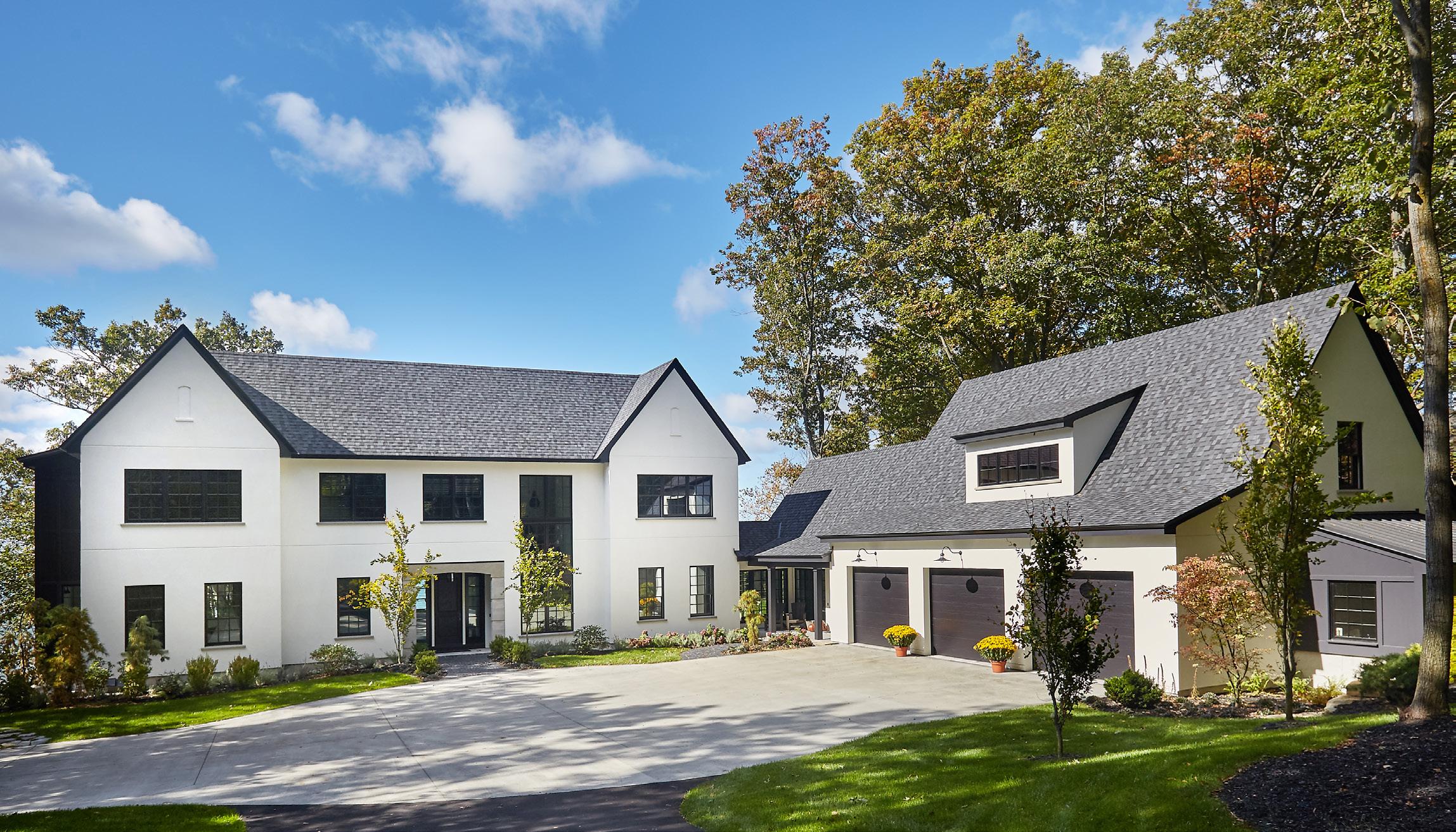














architecture | planning | sustainable design 117 howard street. petoskey mi 49770 www.white-liebler.com 231-347-6870
 Nick Liebler AIA, LEEP-AP Principal Architect
Nick White AIA, LEEP-AP Principal Architect
Nick Liebler AIA, LEEP-AP Principal Architect
Nick White AIA, LEEP-AP Principal Architect










In the 19th century, the Japanese refined the use of the Shoji door with sliding and removable panels. This new type of back door connecting the room to the garden expanded the living space rather than acted as a barrier. The doors were affection ately referred to as the eyes and skin of the home.
When Shoji doors were exported to Europe and America in the mid-1800, the feeling of light and openness that they featured influenced many new home designs. The most popular appli cation of this theme was highlighted in the architecture of Frank Lloyd Wright. His aim was to create a “whole living environ ment” by using more glass in the building envelope. After World War II, the modern architectural movement saw the role of windows changing as windows became walls. But what if those glass walls could move, opening up the entire space to the outside?
The sliding glass patio door was the next step. But there were a few design challenges holding it back; poor weather resistance without high, unseemly sills, a lack of ease of use, and size limitations. In the 60’s, a German company created a new breed of sliding doors to address some of these issues, the Hebeschiebe Tür (trans lated: the liftslide door). Its design had the potential to solve many of these and open up new
possibilities in how architecture impacted lifestyle.
In the 80’s, a California entrepre neur took the liftslide door’s early technology and adapted it to the American home. These design changes led to minimal profile sills with unmatched weather perfor mance, ease of operation for oversized panels, and limitless configurations such as curved, corner and pocketing doors that could be built with larger panels.
Today, it’s possible to seamlessly integrate the indoors and outdoors with confidence, knowing that performance isn’t sacrificed.
Today, it’s possible to seamlessly integrate the indoors and outdoors with confidence, know ing that performance isn’t sacrificed. The liftslide is unique in how big the panels can be and still slide effortlessly on a minimal track. It’s a big door for big views, and its exceptional performance brings peace of mind. These new sliding patio doors now connect the homeowner with their environment, adapt to site specif ic design and integrate advanc es in environmental design by enhancing the use of light, ventilation and space, ultimately providing freedom from tradition al barriers.
Many new opportunities lie ahead in the way people can live and interact with their homes and surrounding environment. The liftslide offers solutions to these architectural aspirations.







The past 40 years have seen a seismic change in the practice of architecture –particularly with regards to custom residential design. Prior to the 80’s, most architectural practice was focused on various forms of commercial design. The introduction of luxury golf course developments soon after, allowed custom residential design to become a respected form of architectural practice. In many ways, custom residential design and construction is much more complex than most commercial work. Whereas commercial work tends to fill a business need, custom residential design is more expressive of an owner’s desires and is not just a ‘means to an end’ but often the ‘end’ itself. Custom residential work usually takes considerably more time to execute than commercial work. Often, the site is much more challenging, the detailing more extensive and the spatial relationships more complex. Because of all of these factors, the value to having a custom home professionally designed could not be greater.
As custom residential work has evolved, so has the complexity of the design solutions and the expertise required to execute these design solutions. In the past, a drafting service was all that was usually needed for most residential work. With the evolution of the complexity of custom residential design, this is no longer the case. To be clear, there’s nothing wrong with a drafting service; it’s just a question of appropriateness. While it’s still true that a licensed architect isn’t really necessary for homes that cost up to three or four hundred thousand dollars, once the construction cost gets over that amount, a prudent owner should start to consider the benefits of hiring an architect. Once the cost becomes greater than a million dollars, the decision not to use a licensed professional is a classic example of “penny wise but pound foolish.”
It comes down to education, expertise and experience. To become a licensed architect takes a minimum of eight years of study and experience before even becoming eligible to take the State Board Exams for licensure. Of those taking the State Boards, only about 20% pass at any given time. In short, to become a licensed architect is a very time consuming, demanding and selective process, and those that take the time and put forth the effort to become licensed are more than qualified individuals.
So why are drafting services utilized in the design of multi-million dollar custom homes? It comes down to cost. It’s usually a lot less expensive to hire a drafting service rather than a licensed architect. Sadly, the old adage “you get what you pay for” couldn’t be more true. In addition to the design work, a thorough knowledge about structure, mechanical and electrical systems and construction administration are usually part of the service an architect provides. These services are rarely provided by a drafting service. Often, these shortcomings only become evident once the project is well underway, much to the chagrin of the owner.
The housing explosion of a few years ago provided a great example of this, particularly in the multi-million dollar ‘spec’ market. A very large number of ‘spec’ homes were designed by drafting services. One fact that seemed to be lost during this period was that there weren’t many people that could afford a home of this value and the ones that could were usually well educated and therefore discerning buyers. Many of these homes were not well conceived or constructed, and constituted a very large portion of the multi-million dollar homes that ultimately went ‘back to the bank’. Amazingly, most banks were entirely unaware that they were loaning incredible sums of money to developers that didn’t
want to spend the money to hire a licensed architect or contract with a high-quality builder. In reality, these banks became unknowing financial partners in projects that were doomed to failure because of these shortcomings.
Is there a quantitative value to utilizing the services of a licensed Architect? One experienced real estate firm that focuses on the sale of quality custom homes sought to find out. This firm researched case studies on over a hundred transactions over the past several years, and the results were both startling and enlightening. They found that homes designed by licensed architects sold for a price that averaged 17% higher, on a per square foot basis, and the days a home was on the market was about 21% less than those designed by a drafting service. Additionally, when a group of over a hundred of the top producing realtors were polled, they felt that the homes designed by a licensed architect added about 23% to the value of a home. These are significant numbers and should be considered by anyone contemplating the design and construction of a custom home.
So where does this lead us? As the complexity and level of detail in the custom home market has increased, the value of using a licensed architect and putting together a quality team to construct a custom home has become increasingly apparent. If we do not wish to repeat the mistakes of the previous market, we must recognize the difference that a professional design team brings to a project. Not only does the team contribute during the design process, but, because they assure a quality level of construction, a professional team should give the banks and other financial institutions the confidence to move forward recognizing that this significantly reduces their risk.














Waking up in a Hästens bed is an eye-opener about the value of perfect sleep. It’s built with the ultimate combination of nature’s materials – together with tireless craftsmanship. You can’t see it. But you’ll definitely feel it. 24 hours a day.
HÄSTENS DETROIT | 100 S Old Woodward Avenue Birmingham, MI 48009 | (248) 940-5466










Illumination design has become the most important trend in interior design, complimenting architecture and nature, creat ing visually pleasing spaces, and improving visibility. With new developments in technolo gy, keeping up with the latest trends is essential.
In 2016, due to nationwide and federal code restrictions on use of incandescent light, the hottest movement is switching to all LED lights. The cost savings benefits and the eco-friendly benefits put this on the top of the list.
“LED lighting is 6-7 times more efficient than conventional lighting and can last up to 25 times longer.” - US Department of Energy.
The benefits of using LED light and the growth of new technol ogy make this revolutionary in lighting design. Designers are no longer constrained to traditional templates and can customize light to fit any application. Innovative companies are lighting the way with new LED technology. Customized LED light strips to fit any installation make it easy to convert all your lights to LED. LED Closet Lights with a seamless fit are helping us distinguish our navy blues from our blacks. Undercabinet and puck lights are lighting cabinets with no heat and without dam aging our art and fabrics.
Flexible LED strips are contouring around curves. Color changing LED light strips are adding zing
to your entertainment areas. Outdoor rated LED lights are lighting driveways, patios, and gardens, expanding our living space.
High Color Rendering Index (CRI) LED lighting means more accurate optical color repre sentation. Color temperature and CRI remain consistent during dimming, unlike incan descent, which change color temperature and effect true color of art, fabrics, walls, and floor finishes. You maintain the richness of color with LED lighting creating a more realis tic, natural look, making this the perfect lighting choice.
The next frontier in lighting is the control system.
Dimming and sensors have been around for years, howev er, controlling these functions has improved tremendously with new technology. Advanced control systems can store personalized settings for multiple lights, allowing you to completely tailor the lighting scheme in any room. With such precise and powerful control, you can completely craft the look and feel for any space, as well as its functionality and efficiency. Light technology is rapidly developing. Sophisticated devices communicate with each other allowing for one touch control systems to control more than your lights. Smart technology is opening up more opportunities for complete
connectivity. Controlling your home’s audio and security has never been easier with the simple installation of a light bulb. When all of your devices work together you can experience the magic of a smart home. Light as art has become the final step in customizing your visual space.
Lighting is an inexpensive and simple way of adding flourish to any room, making light a design element. Lighting designers are trained to choose the best light spectrum for the space to achieve the best quality of light. Lighting must be carefully planned to suit the space it is illuminating. The inclusion of a couple of different schemes within one space can single-handedly change the perceived use of a space. Creating mood and atmo sphere in a space using light is a powerful tool.
“When light becomes art, spaces become more enjoyable, life is more productive, and the soul is enriched.”
The challenge to make healthi er lighting by adjusting bright ness and color of light is gradu ally getting easier and cheaper. Stay inspired and up to date with these hot trends to experi ence light in the new age.
We believe that every home is unique and every our window must be custom-made one at a time. EWG will craft window of any shape and color for your home form material of your choice, ranging from aluminum to exotic wood spices and even covered it with real bronze from outside. Our specialty is large size picture windows up to 20 feet tall and 10 feet wide. Our slim frame sliding doors can be made up to 14 feet tall and 10 feet wide per panel.
All EWG products meet highest quality, performance, security and aesthetic standards. All of our products are energy efficient glazed with modern insulated double or triple glass panels. Visit ewgwindows.com for more information.














